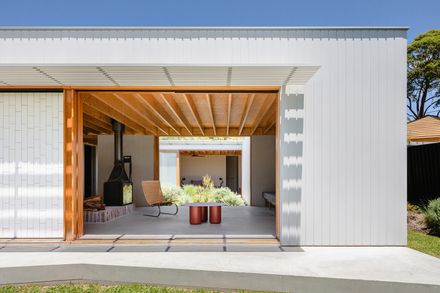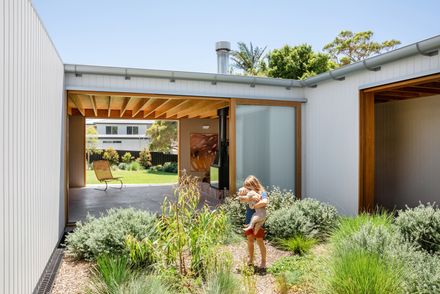ARCHITECTS
Tribe Studio Architects
PRINCIPAL ARCHITECTS
Hannah Tribe
ENGINEERING
Cantilever Consulting Engineers
BUILDERS
Ballast Construction, George Payne
LANDSCAPING
Christopher Owen Landscape Design
PHOTOGRAPHS
Katherine Lu
YEAR
2020
LOCATION
Bundeena, Australia
CATEGORY
House
Tribe Studio Architects has unveiled their latest residential project, a single-story holiday house in the beachside hamlet of Bundeena, located south of Sydney in the Royal National Park.
The design for the home doubles a replicable architectural prototype for a sustainable holiday home that is authentic to the Australian aesthetic, whilst also being cost-effective, environmentally aware and supportive of local trades.
Developed as a weekender, the pared-back timber courtyard home nods to the modest fisher-cottages prevalent in the area and celebrates its native garden setting. It is an understated economical achievement with high levels of architectural and environmental integrity.
“This house is a retreat from busy city lives that encourages a slower way of living by the beach. It is a garden and cooking focused holiday home and a place where children and adults are connected,” explains Hannah Tribe, principal of Tribe Studio Architects.
Situated 100-metres from Gunyah beach, the block has seven adjoining neighbours, making its context both coastal and suburban.
Tribe chose not to pursue a double-storey home to capture water views, in favour of tackling the larger challenge of creating an affordable and sustainable prototype home, with the potential to be recreated across a variety of environments – from beach and bush to suburban estates.
"We could have had glorious views from a second storey, however we felt that reinforcing the local vernacular of single-storey timber cottages was important, and that an introspective garden diagram was preferable to outward-looking in this context,” recalls Hannah.
“This house is an attempt to achieve a high level of architectural and sustainable outcomes at a low cost. It is an experiment in delivering a more thoughtful kit home”.
Planned around an internal courtyard, the U-shaped form responds to multiple orientations. The mathematical rigour and strict organisational framework starts with a concrete slab and modular timber frame that cleverly achieves large spans of up to 5.4 metres without structural steel.
Living and sleeping spaces wrap around the courtyard and face north to the rear garden.
Two adults’ bedrooms and a kids’ room that can sleep up to six children means the home is ample for a family of four and – with built-in sofas that double as beds in the lounge – easily accommodates up to twelve when friends come to stay.
In lieu of a mudroom, pushing the laundry and bathroom to the entry threshold is a deliberate sand trap for beach towels, tossed togs, wetsuits and thongs.
In lieu of a mudroom, pushing the laundry and bathroom to the entry threshold is a deliberate sand trap for beach towels, tossed togs, wetsuits and thongs.
Internally, a relaxed and raw aesthetic contrasts the architectural rigour. Materials are durable and honest. The timber used throughout is certified plantation. Laminated veneer lumber (LVLs) and structural ply ceilings are clear matt finished revealing their knots and imperfections.
There is no plasterboard, just crisply painted timber walls and hardwood window joinery in Australian Blackbutt. The finish on the structural concrete floor is unpolished so that wet and sandy footprints are a non-issue. While the house is conceived as a prototype kit-home, it also reflects some particularities of the site.
The front façade is windowless in response to street geometry and approaching headlights. The external blank wall frames an exquisite existing Queensland bottle tree. Setbacks are determined by other mature trees on-site and relationships with neighbours.
Tribe engaged landscape architect Christopher Owen to enhance the garden. His landscape plan fosters natives and endemic species that attract bird life including kookaburras, tawny frogmouths, cockatoos, fairy-wrens and sea eagles. The only non-indigenous plants are edibles
These were originally dispersed throughout the garden but have been moved in an attempt to deter roaming deer from grazing. Now the courtyard is the ‘food bowl’ of the house.
Sustainable measures embedded in Tribe’s philosophy are expressed throughout this house. Eschewing structural steel was both an eco- and budget-friendly choice.
Passive cooling and heating are achieved through the thermal mass of the concrete slab and by orienting the house to prevailing cooling breezes. All windows are double glazed and lightweight walls are heavily insulated
Adding adjustable shading to east and west windows as well as awnings to north-facing windows reduces solar gain. As a result, there is no need for air-conditioning, just ceiling fans in the bedrooms.
The highly efficient French Philippe Chemise fireplace became a justifiable extravagance given it heats the entire house. Lighting is all LED. A 5kw photovoltaic array, separate solar hot water, and provision for a future battery leans the home toward electrical self-reliance
Rainwater harvesting and recycling to all WCs, washing machines and garden irrigation makes the home water-wise.


























